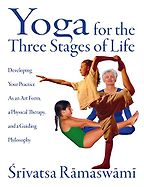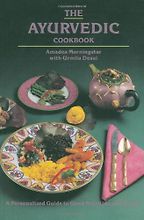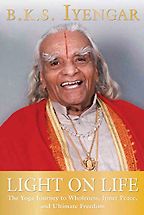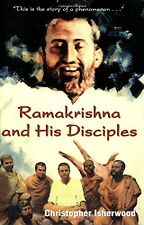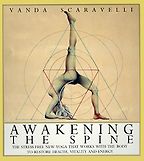Before we discuss your selection of books, what is yoga?
That’s a question with so many answers. There are a multitude of definitions of yoga. With this selection of books I’m hoping to give an idea of some of them.
It’s definitely not a form of fitness. We could define it as a series of postures to enhance well-being and mind-body balance—that’s what yoga has (mostly) come to mean in the West. But who owns yoga? It comes from this very ancient tradition where it meant something completely different—although that doesn’t mean it has to stay that way.
What did it mean originally? Was that tradition closer to a religion?
It’s a tradition rooted in a religion—if you can call Hinduism a religion. It wasn’t until the British came to India that Hinduism came to be considered a religion or to be labelled Hinduism. A label was slapped on all these traditions and practices that weren’t Muslim or Buddhist. The British colonizers needed some way to define this amorphous, fluid body of disparate traditions and practices. They found it very confusing because there was no one book, no one authority.
“Srivatsa Ramaswami provides a great introduction to the theory of yoga”
Yoga comes from the Vedantic tradition, which today is inscribed within Hinduism. That’s where its origins are. You can’t really argue with that. It comes from a very ancient tradition, a Hindu tradition. The first part of my first book choice, Yoga for the Three Stages of Life by Srivatsa Ramaswami, provides a great introduction to the theory of yoga. He’s somebody much more learned than me and he traces out a classical definition of yoga.
Why else have you chosen this?
Because he covers all the bases. He starts off defining yoga classically. In the very beginning, he starts by saying a bit about himself, which is a very traditional way of doing things, explaining how he has some authority to speak. He explains how he studied with a man called Krishnamacharya. If we’re talking about yoga and the West, you can trace everything back to him. All the great teachers including B K S Iyengar, Pattabhi Jois and many others were his direct students. I can trace my teachers back to him. He did an enormous amount to popularise yoga in the early 20th century and lived to a ripe old age.
Ramaswami starts by saying who he is, who his teacher was, and gives us the classical definitions and goes into detail with a lot of Hindu stories. Then he goes on to deal with the physical practice (asana), not in huge detail but enough, and then he covers breathing practices (pranayama) and also says a little bit about yoga for women and little bit about the yogic texts. So he’s covered everything. It’s a great book for anybody who wants to find out more about yoga.
Will this book teach you how to do yoga?
You can’t really learn yoga from a book, but this book is a great point of reference for some postures and for breathing and so on. After all, would you learn how to swim from a book? Is that even possible? Maybe for one or two people . . . but for most of us it’s best to have a teacher.
The next book is The Ayurvedic Cookbook by Amadea Morningstar.
In classical thought, yoga is for the mind and Ayurveda is for the body. What you put into your body is going to influence your mind. I don’t know if you subscribe to that, but yogis do.
This is a wonderful cookbook, with recipes for everybody. In Ayurveda, if you go see an Ayurvedic doctor, they’re going take your pulse, look at your tongue, and ask some questions so as to identify your constitution. There are three main types of constitution—Vata, Pitta and Kapha—but nobody is exclusively one. We’re all a mix, but usually there is one predominant or maybe two predominant types and a lesser one. And so then if you want to live Ayurvedically, you will live in order to maintain a balance. You don’t want your dominant type to become exacerbated. It’s all about balance.
This cookbook has so many recipes. It tells you which qualities a particular dish will increase and decrease so that you can eat in such a way as to maintain balance.
Is it mainly vegetarian?
Not necessarily. There’s nothing right or wrong. It depends what your goal is. If you are a soldier, for example, and need to be strong and aggressive to fight, they would advise you to eat rajasic foods. Chilies and meat would be recommended, although I’m not sure that they think the flesh of a dead animal is very healthy.
But yes, most of the food is vegetarian. Every product of the cow, in the Hindu tradition, is sacred, so they use a lot of milk and and butter and ghee in cooking—and even cow dung to plaster the walls of a yoga room is considered a very good thing.
Your next book is Light on Life by B K S Iyengar.
He is another one of these direct students of Sri Krishnamacharya, like Srivasta Ramaswami. Ramaswami was with Krishnamacharya for something like 60 years because he lived in Chennai and his family was connected with Krishnamacharya. He studied with him for longer than pretty much anybody else, whereas B K S Iyengar was only with Krishnamacharya for a short time when Krishnamacharya was the yoga teacher at the Palace of the Maharaja of Mysore. That is also where Pattabhi Jois, who is the father of Ashtanga, studied.
The reason B K S Iyengar is often considered to be the father of yoga in the West is because he had a very famous student called Yehudi Menuhin. That was back in the 70s; Yehudi Menuhin popularized yoga and made it respectable. So he’s super important in the evolution of the western yogic tradition.
“You can’t really learn yoga from a book”
He wrote a book called The Tree of Yoga, a sort of encyclopaedia of yoga postures. It includes instructions on how to perform them, outlining any contraindications and enumerating all their benefits. He was publishing books on yoga long before everyone else. He also had a yoga institute in Puna, where they took in students and also trained teachers. They’ve been doing that for a long time. All that’s added to his influence.
Iyengar puts a lot of emphasis on alignment. All the students of Krishnamacharya who have become big-name teachers in the West have different systems. There’s lots of crossover, but actually quite a lot of difference, too. These differences could be explained by the fact that these various teachers spent time with Krishnamacharya at different times of his life. And if you practice yoga for a long time, you find that your practice changes over time. The emphasis you put on this or that changes, which I think is healthy and normal.
B K S Iyengar has written a number of other books, not only Light on the Yoga Sutras of Patanjali but also and Light on Prãnãyãma and many others. The book I’ve chosen, Light on Life, was written when he was relatively old; in it, he’s looking back. It’s very much an overview. He goes from the gross physical body to subtler factors, to the subtle body and ultimately to the soul. That’s the trajectory—it’s the inward journey. It’s a beautiful book by a great yoga master looking back at a life of yoga.
Moving on to the next of your selection of yoga books, we have Ramakrishna and His Disciples. I was very surprised that you chose a book by Christopher Isherwood. Before this, all I knew about him was that he was a writer who’d spent time observing the rise of Hitler in Germany in the 1930s.
I think Christopher Isherwood was connected with the Ramakrishna movement in California and with Swami Prabhavananda; he translated the Bhagavad Gita and two other Hindu scriptures. The reason I chose this book is because in India when people say, ‘Oh, so-and-so is a great yogi’, they’re not talking about the physical postures. Most people in India, certainly older people, would be talking about a realized soul, about a saint or something like that, and Ramakrishna was such a saint. He is a classic example of what a traditional Indian, particularly Hindu, might refer to as a ‘great yogi’. I think it’s important, at least in the way I think about yoga, to keep a sense of the breadth of the tradition.
Five Books interviews are expensive to produce. If you're enjoying this interview, please support us by donating a small amount.
I love this book because for one thing it’s just a great story, well-told. A lot of books about Indian sages are written in such a way that they just send you to sleep . . . But Ishwerood is a great writer, and he’s smart. He explains lots of things about Hindu tradition and thought throughout. It’s actually a very informative read on that level.
What did Ramakrishna do with his life?
He was a very simple man born into a peasant family in Bengal close to Calcutta. He was unusual and, as he grew up, people recognized that there was something quite different about him, something very special. He came to be known during his own lifetime as a great saint, a great soul.
When he died, his close followers founded the ‘Ramakrishna Mission’, which is active in India and, to a lesser extent, all around the world to this day. As well as being involved in spiritual and religious teachings, they carry out extensive educational and philanthropic work in India.
Swami Vivekananda was one of Ramakrishna’s principal disciples. His speeches at the World Parliament of Religion in Chicago in 1893, promoting peace and tolerance, are famous to this day.
And your last book is Awakening the Spine by Vanda Scaravelli.
Vanda Scaravelli was a very cultured Italian woman who came from a very musical family. In her 40s she met B K S Iyengar when the Indian philosopher J. Krishnamurti was staying at her family villa near Florence. Iyengar would come every morning to give a yoga lesson to Krishnamurti and he began also to teach Vanda. She went on to study with Krishnamacharya’s son, T K V Desikachar, and over time became a teacher of yoga herself.
This book is beautiful. It’s very visual—every short text is accompanied by an image, mainly photographs, many of nature rather than of anyone ‘doing yoga’. She conveys her vision or understanding of yoga in a very impressionistic way through these pictures. It’s a book about how rather than what to do, an extremely beautiful book by somebody with the spirit of an artist. That’s what makes it very special.
What is an awakened spine?
An awakened spine would be a spine with no constriction, with energy flowing freely through it. We’re not talking about Kundalini energy necessarily, but more about just moving in a way that allows your spine to be free throughout your life, well into old age, like her. So, yes, you’re doing these yoga postures, but in your normal daily life as well, you’re able to carry on moving freely and in a pain-free way.
Ultimately, all of this is rooted in the tradition of some sort of improved spiritual well-being. Is that right?
The root of the word yoga in Sanskrit means ‘union’. It’s all about union with God, about merging the individual soul with the ‘Universal Soul’. A merging with God, whatever your conception of God is. That is the aim of yoga.
Five Books aims to keep its book recommendations and interviews up to date. If you are the interviewee and would like to update your choice of books (or even just what you say about them) please email us at [email protected]
